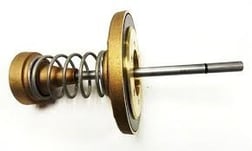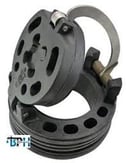Historically, the fire sprinkler industry has been hesitant to install backflow preventers on a high pressure sprinkler system. They have to make  sure the fire sprinkler system has enough pressure to effectively distribute the water to where it's needed so it can save lives. Old style check valves like the one pictured to the right gave them a headache. These valves caused the pressure to drop which brought about many problems in the sizing of the high pressure sprinkler system and the delivery of pressured water to a fire. That creates a system where the industry needed to choose between stopping backflow for water system safety and keeping up the pressure for fire safety. Then, in 1989, Doug Powell at Ames created the Silver Bullet - a double check backflow preventer with a revolutionary check design which drastically reduced the pressure drop across the valve.
sure the fire sprinkler system has enough pressure to effectively distribute the water to where it's needed so it can save lives. Old style check valves like the one pictured to the right gave them a headache. These valves caused the pressure to drop which brought about many problems in the sizing of the high pressure sprinkler system and the delivery of pressured water to a fire. That creates a system where the industry needed to choose between stopping backflow for water system safety and keeping up the pressure for fire safety. Then, in 1989, Doug Powell at Ames created the Silver Bullet - a double check backflow preventer with a revolutionary check design which drastically reduced the pressure drop across the valve.
Once this new and improved check valve hit the market, fire sprinkler engineers and design-build contractors could now design their systems with a much lower pressure drop across the system, and still prevent the backflow of sprinkler water into the public water supply. .
High pressure sprinkler systems have also continued to evolve and advance. Now, the use of anti-freeze in sprinkler systems has become common practice, especially in cold-weather environments. The introduction of chemicals into the sprinkler system has changed what has historically been a "low hazard" system into a "high-hazard" one. High hazards include water systems with chemicals as well as other materials. For instance, domestic lines for restaurants, hospitals, and car washes are typically labeled as high hazard. These systems require more protection than a double check backflow preventer can provide. Instead, they need RPZ valves to protect the water supply. Unfortunately, RPZ backflow preventers introduce a couple of issues that fire sprinkler designers must contend with:
- RPZ backflow preventers use an additional relief valve for greater backflow protection, but the added protection increases the pressure drop across the valve. Sprinkler system designers have to accommodate for this additional pressure drop with either larger pipe diameters throughout the system or create higher supply pressures with a pump.
- RPZ devices dump water from the relief valve. This causes installation issues because they cannot be installed below ground in a vault, and installing them inside the building creates a flood risk.
- RPZ backflow assemblies should be installed outside, above ground, and protected with an ASSE 1060 heated enclosure.
In today's water environment, municipalities and water districts across the US are seeing the explosive growth of RPZ backflow preventers throughout their entire water systems. Since each public water system determines their own rules for what constitutes low or high hazard, knowing when to use an RPZ valve or a double check can be difficult. Instead of trying to classify installations as "low-hazard" or "high-hazard", some water systems are simply enforcing the use of RPZ backflow preventers on ALL installations. This includes even the traditionally "low-hazard" fire systems. Engineers and design-build sprinkler contractors are increasingly having to adjust their systems to accommodate RPZ backflow preventers, and the trend will only increase in the future. Although this practice is sometimes unnecessary for some installations, the enforcement of RPZs throughout a water district increases the overall protection of the water supply. There is no turning back to allowing cross connections in favor of a simpler design. A well protected water supply is a good thing for everyone.




